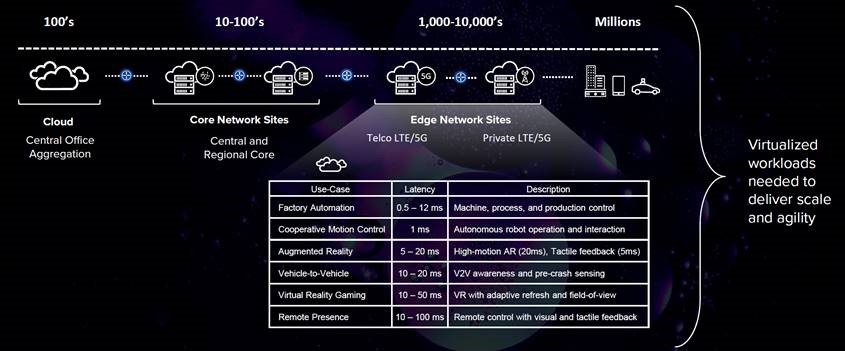The world is accelerating around us. Consumer and enterprise demand for our networked services is advancing at pace too, driving appetite for more incredible speeds than ever. Today, 4G networks power these services, delivering latency of around 50ms. But, says Dan Graham, global product leader, Mobile Edge Computing at World Wide Technology, with service providers rolling out 5G, we are suddenly promised latency levels as low as 2 to 3 milliseconds.
For context, it takes 10ms for an image seen by our eyes to be processed by our human brains. The latency promised by 5G is impressively low, so self-driving cars and virtual reality experiences can finally be realised.
Yet there is still a catch. The trip to and from a distant data centre to deliver user services can still take 100 to 500 milliseconds or more. Such a delay is a serious barrier to making these kinds of 5G services a reality. It illustrates entirely why Mobile Edge Computing (MEC) is such an essential piece of the 5G puzzle.
Neither 5G nor the Network Edge are standalone technologies. They are a set of technologies that must work together to provide the high bandwidth and low latency connectivity that will drive new sets of innovative services and applications for businesses and consumers alike.

World Wide Technology
Because 5G services are delivered via disaggregated and virtualised platforms, well-orchestrated integration and scale are paramount to their success. However, this puts a heavy burden on network operators, who have become accustomed to the proprietary, vertically integrated approach.
The integration required to enable Edge to interact with a 5G network is inherently complex and often requires a specialist skill set. Systems integrators can play a vital role here to bring complementary expertise, helping service providers select best of breed components for their 5G services platform, validate that they interoperate as intended, and make it easy to deploy at scale.
Complexity obstructs Edge’s promise
Service providers understand that 5G and Edge represent a considerable opportunity to deliver speed and agility to enterprise customers. WWT research shows Edge is a US$17 billion market opportunity for service providers, and IDC analysts have concluded that by 2025, more than half of new infrastructure will be deployed in Edge locations.
However, Edge solutions are inherently complex. Service providers and their end customers need fully integrated hardware and software solutions that are interoperable and scalable. This naturally poses challenges for service providers.
Nuanced decisions about hardware, networking, and infrastructure must be made. If issues arise, this can significantly disrupt both the rollout of new services and increase the time it takes for 5G and Edge investments to mature.

Furthermore, the network’s decentralisation pushes operators to adopt a more software-centric approach, including dev ops and CI/CD, to increase their offered services’ agility. This is an unfamiliar territory which breaks apart service providers’ ability to have a single point of contact for troubleshooting and fixes.
The solution: Converged Edge
To address this problem, service providers need to build out converged infrastructure at their Edge locations. Large cloud data centres that aggregate central and regional core sites to deploy network services are familiar territory. Still, in a 5G world, service providers will have to leverage Edge network sites to deliver against expectations around low latency.
A converged Edge Node sits at these Edge sites — both on-premise (private networks) and within the service provider Edge (telco Edge). This infrastructure groups multiple IT components — servers, storage, networking infrastructure, infrastructure management software, automation, and orchestration — into one optimised package.
The goal is to centralise infrastructure resource management, consolidate systems, lower costs, and increase resource-utilisation rates, consistency, and availability.
Converged Edge solutions can relieve carriers of the burden of being a software company by providing an integrated approach that makes 5G infrastructure easier to roll out and more straightforward to consume for enterprise customers. Get it right, and you have the possibility of creating new experiences that, in turn, drive new revenue opportunities.
The value of customisation
Getting to the point where you successfully realise new revenue streams is the challenge, and it requires customised solutions that can be tailored to meet each business’ needs. Very few service providers are interested in “off the shelf” solutions that don’t mirror the unique experience they’re looking to deliver to their customers.
By working with systems integrators, service providers can jumpstart their deployment strategies by gaining access to pre-validated architectures, which would take upwards of a year to design, test, and validate independently. From there, operators can collaborate to develop unique solutions that use the blueprint foundation to reduce time to market and deliver innovative new services.

Collaboration with integrators is vital to 5G and Edge solutions’ success because any interoperability or security issues can substantially impact service providers’ ability to deploy solutions and quickly generate a return on investment (ROI). Integrators have the resources to provide testing environments that can model multi-vendor architectures and help service providers integrate at scale with confidence.
Competitive Edge
Edge architectures must be consistent and easy to consume — for both service providers and their end customers to succeed. When that happens, the benefits are clear.
Converged infrastructure offers a platform capable of delivering connectivity via Private LTE and Mobile Edge Computing and virtualised network services, so that service providers can realise the value of the Edge in the short term.
Meanwhile, it can enable a more agile service creation platform that allows for new revenue-generating services to be deployed via software instead of full-fledged infrastructure deployment. Using this approach, service providers can cut next-gen network deployment time from several years to a few months and accelerate their time to revenue. Get it right, and a converged Edge can become a service provider’s competitive edge.
The author is Dan Graham, global product leader, Mobile Edge Computing, at World Wide Technology.










